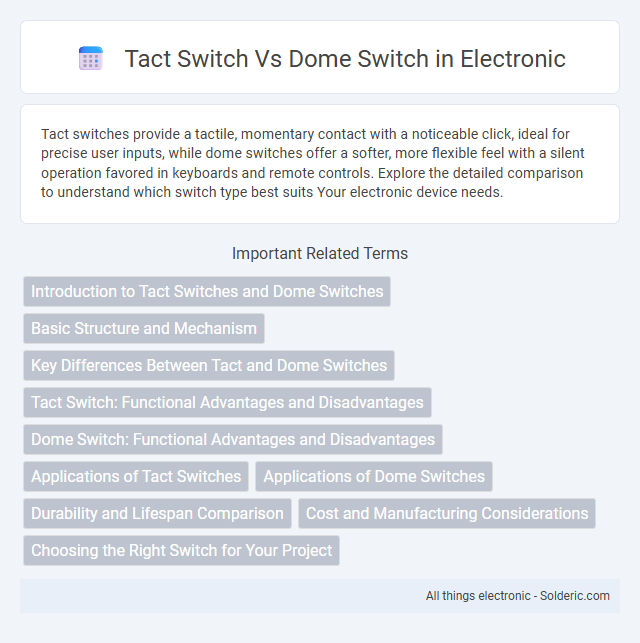Tact switches provide a tactile, momentary contact with a noticeable click, ideal for precise user inputs, while dome switches offer a softer, more flexible feel with a silent operation favored in keyboards and remote controls. Explore the detailed comparison to understand which switch type best suits Your electronic device needs.
Comparison Table
| Feature | Tact Switch | Dome Switch |
|---|---|---|
| Operation | Physical push-button with tactile feedback | Metal or polymer dome collapses to make contact |
| Size | Typically small, compact, varies by model | Thin, low-profile, ideal for slim designs |
| Durability | High cycle life, commonly 100,000+ actuations | Medium to high, around 500,000+ cycles depending on dome type |
| Tactile Feedback | Distinct tactile "click" | Subtle to moderate tactile response |
| Application | Keyboards, consumer electronics, control panels | Membrane keyboards, remote controls, medical devices |
| Cost | Generally low-cost | Cost-effective for mass production |
| Mounting | Through-hole or surface mount | Usually integrated in membrane layers |
Introduction to Tact Switches and Dome Switches
Tact switches are small, tactile push-button switches that provide rapid, momentary contact closure with a distinct click sensation, commonly used in consumer electronics for precise user input. Dome switches consist of a flexible membrane with metal domes that collapse when pressed, offering consistent tactile feedback and durability in membrane keyboards and control panels. Both switches serve as essential components in input devices, differing primarily in their mechanical design and tactile response.
Basic Structure and Mechanism
Tact switches feature a small, rectangular housing with a movable metal dome that collapses when pressed, creating a tactile feedback and completing the circuit. Dome switches consist of a flexible, dome-shaped metal or polymer placed over a circuit board; pressing the dome deforms it to establish electrical contact. Both switch types rely on mechanical deformation to activate electrical circuits but differ in dome design and feedback characteristics.
Key Differences Between Tact and Dome Switches
Tact switches feature a mechanical spring mechanism that provides a tactile click feedback, whereas dome switches rely on a rubber or silicone dome that collapses to complete the circuit, offering a softer press sensation. Tact switches are typically more durable and suited for applications requiring precise actuation, while dome switches prioritize a quieter user experience and cost-effectiveness. Your choice between them should consider the desired tactile feedback, lifespan, and noise level for the specific application.
Tact Switch: Functional Advantages and Disadvantages
Tact switches offer precise tactile feedback and durable mechanical design, making them ideal for applications requiring reliable on/off input with distinct clicking sensations. Their advantages include high actuation force consistency and long lifespan, while disadvantages involve larger size compared to dome switches and higher manufacturing costs. Tact switches are preferred in devices demanding robust user interaction and accuracy, despite limited flexibility in design and slightly increased noise during operation.
Dome Switch: Functional Advantages and Disadvantages
Dome switches offer tactile feedback and reliable actuation, making them ideal for user interfaces requiring precise input confirmation. They are cost-effective and have a low profile, but may experience reduced sensitivity over time due to wear and can be less durable under heavy use compared to mechanical switches. Their simple construction allows for easy integration in membrane keyboards and control panels, though limited travel distance can affect user experience.
Applications of Tact Switches
Tact switches are widely used in consumer electronics such as remote controls, calculators, and handheld devices due to their reliable tactile feedback and compact size. They are essential in automotive control panels, where precise user input and durability under frequent use are critical. Industrial equipment also relies on tact switches for machine control interfaces, offering consistent performance in harsh environments.
Applications of Dome Switches
Dome switches are commonly used in consumer electronics such as remote controls, keyboards, and calculators due to their tactile feedback and durability. Their design provides consistent actuation force and reliable performance in compact devices, making them ideal for applications requiring multiple key presses. You can find dome switches integrated into appliances and industrial control panels where user-friendly input and longevity are critical.
Durability and Lifespan Comparison
Tact switches typically offer a higher durability with a lifespan ranging from 100,000 to 1,000,000 actuations, making them ideal for frequent use in electronic devices. Dome switches, usually made from metal or silicone, have a lifespan of approximately 1 million cycles but may wear out faster under heavy mechanical stress or environmental factors. Both switch types provide reliable performance, but tact switches generally excel in longevity for high-traffic applications.
Cost and Manufacturing Considerations
Tact switches generally offer lower manufacturing costs due to simpler construction and mass production scalability, making them ideal for budget-sensitive applications. Dome switches feature a more complex design with a metal dome that provides tactile feedback, which can increase production expenses and assembly time. Choosing between the two depends on balancing cost constraints with desired tactile performance and product durability requirements.
Choosing the Right Switch for Your Project
Tact switches provide tactile feedback through a physical click, making them ideal for applications requiring precise user input and durability, while dome switches offer a softer, quieter response suitable for low-profile designs and cost-effective solutions. When choosing the right switch for your project, consider factors such as actuation force, tactile feel, lifespan, and environmental resistance to ensure optimal performance. Your decision should align with the user experience and mechanical requirements specific to your device's functionality and design constraints.
Tact switch vs Dome switch Infographic

 solderic.com
solderic.com